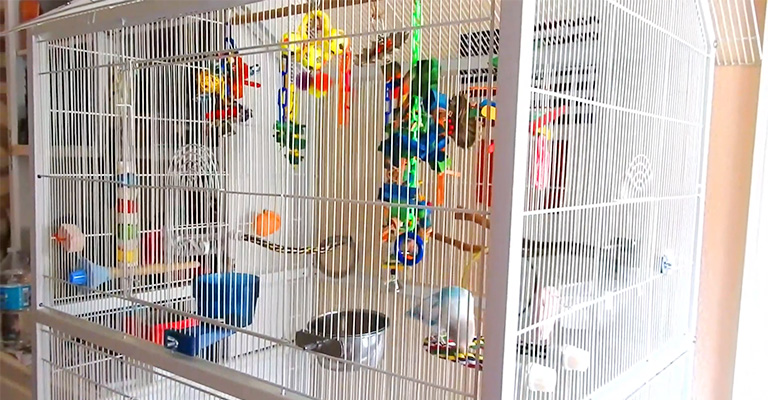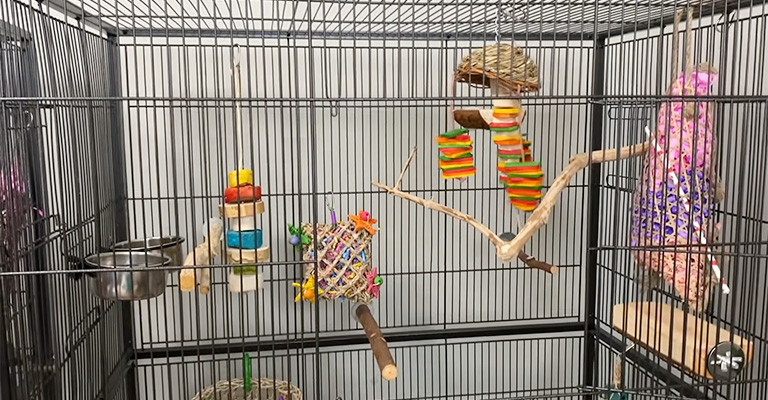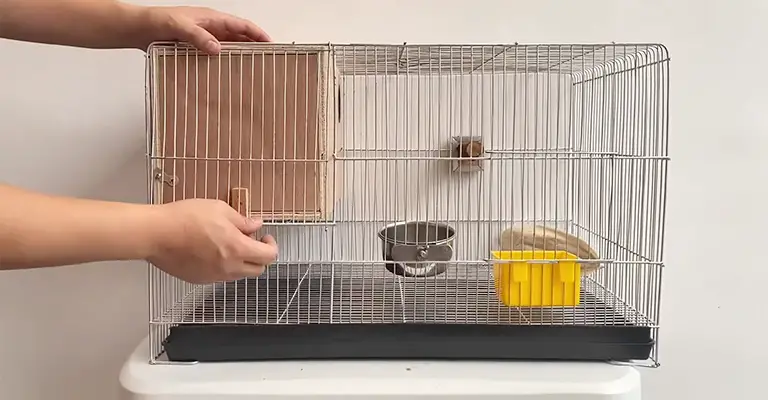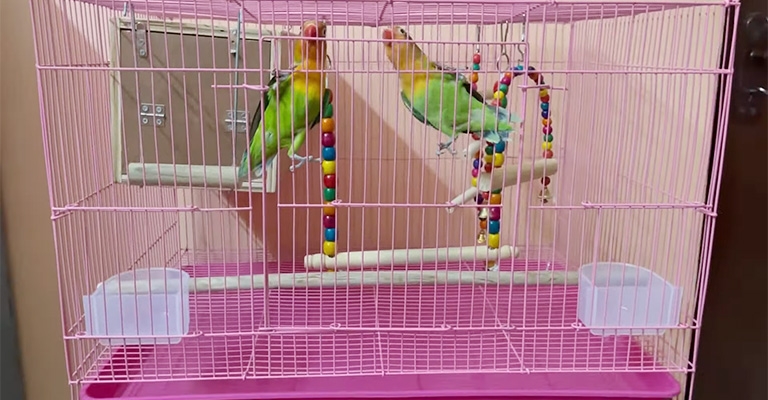Lovebirds, with their vibrant plumage and charming personalities, make wonderful companions for bird enthusiasts.
To ensure your lovebirds thrive and stay happy in your care, it’s crucial to provide them with a suitable living space. Selecting the right cage size is a fundamental aspect of responsible lovebird ownership.
In this blog post, we will delve into the intricacies of choosing the ideal cage size for your lovebirds. Whether you’re a first-time Lovebird owner or looking to upgrade your current setup, we’ve got you covered.
We’ll explore factors like the number of lovebirds, cage materials, bar spacing, and more, guiding you toward creating a safe and comfortable environment for your feathered friends.
Your lovebirds’ well-being and happiness depend significantly on their living conditions, so let’s embark on this journey to find the perfect cage size for your beloved companions.

Where Do Lovebirds Love to Live?
Lovebirds, small parrots known for their affectionate nature, thrive in a variety of habitats across their native Africa. These colorful birds are typically found in regions with dense vegetation, such as woodlands, savannas, and forests.
Lovebirds have a strong preference for nesting in tree cavities, where they can create cozy, hidden nests.
In the wild, lovebirds can be spotted in countries like Tanzania, Kenya, and South Africa, but they are also cherished pets worldwide. When kept as pets, lovebirds need spacious cages filled with toys for mental stimulation.
They thrive on human interaction and bond closely with their owners, making them ideal companions for those who can provide them with love and attention.
Whether in the wild or as beloved pets, lovebirds love to live in environments that offer companionship, safety, and a chance to express their affectionate nature.
Things to Consider When Choosing a Cage Size for Lovebirds

Choosing the right cage size for your lovebirds is crucial for their health and well-being. Lovebirds are active, social birds that require space to move, exercise, and explore.
Here are several important factors to consider when selecting a cage size for your lovebirds:
Species and Number of Lovebirds
The first consideration is the number of lovebirds you plan to keep and their species. Different lovebird species have varying sizes, so it’s important to research the specific species you have.
Generally, a larger cage is better, but as a guideline, a minimum cage size for a pair of small lovebirds should be about 24 inches (61 cm) wide, 18 inches (46 cm) deep, and 24 inches (61 cm) high.
Bar Spacing
Ensure that the bar spacing on the cage is appropriate for your lovebirds. Lovebirds are small parrots and can easily escape from cages with wide bar spacing. Opt for cages with bar spacing of no more than 5/8 to 3/4 inch (1.6 to 1.9 cm).
Horizontal Space
Lovebirds are active birds that love to climb and explore. Choose a cage that provides horizontal space for them to move around and stretch their wings. A wider cage is often better than a tall one.
Vertical Space
While width is important, height also matters. Lovebirds enjoy flying vertically, so choose a cage with sufficient height for them to hop and flutter upwards.
Bar Thickness and Material
The cage bars should be thick and sturdy to prevent bending or chewing. Stainless steel or powder-coated cages are recommended, as they are durable and easy to clean.
Accessories and Perches
Make sure the cage has plenty of perches, toys, and accessories to keep your lovebirds mentally stimulated and physically active. These items should not overcrowd the cage but provide opportunities for exercise and entertainment.
Cleaning and Maintenance
Consider how easy it is to clean the cage. Removable trays and easy access to all parts of the cage are essential for keeping the enclosure clean and hygienic.
Location
Think about where you’ll place the cage in your home. It should be in a quiet, draft-free area away from direct sunlight and extreme temperature fluctuations.
Safety
Ensure that the cage has secure locks and that there are no sharp edges or potential hazards that could harm your lovebirds.
Future Growth
If you plan to expand your lovebird family, it’s wise to invest in a larger cage from the start to accommodate any additional birds.
Remember that lovebirds are social creatures, and they thrive on interaction with their owners. A spacious, well-furnished cage is essential, but it should also be supplemented with regular out-of-cage time for exercise and socialization.
Providing a comfortable and appropriately sized cage will contribute to the overall health and happiness of your beloved lovebirds.
Proper Size of Cage for Lovebirds

The proper cage size for lovebirds depends on the number of birds you plan to keep in the enclosure. Lovebirds are social creatures and thrive on companionship, so it’s important to ensure they have adequate space.
Here are some guidelines for selecting the right cage size based on the number of lovebirds:
Single Lovebird
If you have a single lovebird, the minimum recommended cage size is approximately 24 inches (61 cm) in width, 18 inches (46 cm) in depth, and 24 inches (61 cm) in height.
However, larger cages are always preferable as they allow more room for exercise and enrichment.
Pair of Lovebirds
Keeping a pair of lovebirds is a common choice, and they are generally quite happy together.
For a pair of lovebirds, consider a cage that is at least 30 inches (76 cm) wide, 18 inches (46 cm) deep, and 30 inches (76 cm) high. This additional space provides room for both birds to move around comfortably.
Multiple Lovebirds
If you plan to keep more than two lovebirds, it’s essential to increase the cage size accordingly. For three or four lovebirds, a cage that measures approximately 36 inches (91 cm) in width, 24 inches (61 cm) in depth, and 36 inches (91 cm) in height is a good starting point.
If you have more than four lovebirds, consider an even larger cage to accommodate their needs.
Flight Cages
If you have the space and resources, a flight cage is an excellent option for multiple lovebirds. These are large, spacious cages that allow birds to fly short distances within the enclosure.
A flight cage should be at least 60 inches (152 cm) in width, 24 inches (61 cm) in depth, and 36 inches (91 cm) in height.
Remember that these are minimum guidelines, and providing a larger cage whenever possible is highly beneficial for the well-being of your lovebirds. In larger cages, you can include more perches, toys, and environmental enrichment, which will keep your birds mentally and physically stimulated.
Additionally, always make sure the cage bars have appropriate spacing (no more than 5/8 to 3/4 inch or 1.6 to 1.9 cm apart) to prevent escapes and injuries.
Proper cage placement in a quiet, safe area of your home, along with regular out-of-cage time for exercise and socialization, will contribute to the overall happiness and health of your lovebirds.
Cage Accessories You Will Need for Lovebirds

Providing the right cage accessories for your lovebirds is essential for their mental and physical well-being. These accessories not only enhance their living environment but also contribute to their overall happiness.
Here are eight important cage accessories you’ll need for your lovebirds:
Perches
Perches are essential for lovebirds to rest, exercise, and maintain their foot health. Provide a variety of perches with different diameters and textures to promote foot exercise and prevent sore spots.
Food and Water Dishes
Sturdy, easy-to-clean food and water dishes are necessary. Opt for dishes that attach securely to the cage bars to prevent tipping and contamination. Stainless steel or ceramic dishes are recommended.
Toys and Enrichment
Lovebirds are intelligent and curious birds. Offer a selection of toys like swings, bells, mirrors, puzzles, and shreddable toys to keep them mentally stimulated and prevent boredom. Rotate toys regularly to maintain interest.
Cuttlebone and Mineral Blocks
Cuttlebone and mineral blocks provide essential calcium and minerals for your lovebirds’ beak and feather health. Attach these near the perches for easy access.
Nesting Box
If you plan to breed your lovebirds, a nesting box is necessary. Make sure it’s appropriately sized for your bird species and securely attached to the cage. However, if you don’t intend to breed, it’s best to avoid nesting boxes, as they can encourage territorial behavior.
Cage Cover
Lovebirds need a consistent sleeping schedule. A cage cover helps create a dark, quiet environment, promoting restful sleep. Ensure the cover is breathable and fits the cage properly.
Ladders and Swings
Ladders and swings provide exercise and entertainment for lovebirds. Hang them securely within the cage, ensuring they are appropriately sized and safe for your birds to use.
Bath Accessories
Lovebirds enjoy bathing. You can offer a shallow dish of water or attach a bird bath to the cage for their bathing needs. Regular bathing helps keep their feathers clean and healthy.
Remember to regularly clean and sanitize these accessories to maintain a hygienic living environment for your lovebirds. Additionally, consider the safety of each accessory, ensuring there are no sharp edges or parts that could harm your birds.
Providing a well-equipped and safe cage environment, along with social interaction and out-of-cage time, will contribute to the happiness and well-being of your lovebirds.
Mistakes to Avoid While Choosing a Cage for a Lovebird
Choosing the right cage for your lovebird is essential for their well-being and happiness. To ensure you make an informed decision, here are five common mistakes to avoid when selecting a cage:
Inadequate Cage Size
One of the most significant mistakes is choosing a cage that is too small. Lovebirds are active birds that require space to move, exercise, and spread their wings.
A cage that is too small can lead to stress, boredom, and even health problems. Always prioritize a cage that meets or exceeds the recommended size guidelines for the number of lovebirds you plan to house.
Improper Bar Spacing
Another critical error is selecting a cage with inappropriate bar spacing. Lovebirds are small parrots that can easily squeeze through wide gaps or get their heads stuck in bars that are too far apart.
Ensure the cage you choose has bar spacing that is suitable for your specific lovebird species, typically between 5/8 to 3/4 inches (1.6 to 1.9 cm).
Neglecting Cage Materials
Some cages are made from materials that can be harmful to your lovebirds. Avoid cages with toxic paints, coatings, or materials that can chip or rust over time. Stainless steel and powder-coated cages are safe and durable options that are easy to clean and maintain.
Overlooking Accessibility
The ease of cleaning and maintaining the cage is often overlooked. Neglecting this aspect can lead to hygiene issues and make your lovebirds prone to illness. Look for cages with removable trays or grates and accessible doors that allow you to clean all areas of the cage without difficulty.
Ignoring the Placement
Placing the cage in the wrong location can cause stress to your lovebirds. Avoid putting the cage in drafty areas, in direct sunlight, or near sources of extreme temperature fluctuations.
Lovebirds are sensitive to environmental changes, so selecting a quiet, stable location in your home is crucial for their well-being.
Choosing the right cage for your lovebird involves considering size, bar spacing, materials, accessibility, and placement. Avoiding these common mistakes will help ensure that your lovebirds have a safe, comfortable, and stimulating environment that promotes their physical and mental health.
Always prioritize the well-being of your feathered friends when making cage-related decisions.
FAQs
For a single lovebird, a cage that’s at least 24 inches (61 cm) wide, 18 inches (46 cm) deep, and 24 inches (61 cm) high is recommended. However, larger cages provide more space for exercise and enrichment, which is beneficial for your bird’s well-being.
For a pair of lovebirds, opt for a cage that is at least 30 inches (76 cm) wide, 18 inches (46 cm) deep, and 30 inches (76 cm) high. This provides enough space for both birds to move around comfortably and interact.
Yes, you can house multiple lovebirds together. For three or four lovebirds, consider a cage around 36 inches (91 cm) wide, 24 inches (61 cm) deep, and 36 inches (91 cm) high. If you have more than four, opt for an even larger cage to accommodate their needs.
A flight cage is a larger enclosure that allows birds to fly short distances within it. If you have space and multiple lovebirds, consider a flight cage that’s at least 60 inches (152 cm) wide, 24 inches (61 cm) deep, and 36 inches (91 cm) high to provide ample room for exercise.
A cage that’s too small can lead to stress, behavioral issues, and health problems in lovebirds. They may become bored, stressed, or develop physical ailments due to lack of space. Providing an appropriately sized cage is essential for their mental and physical well-being.
Wrapping Up
The right cage size is a pivotal aspect of providing the best care for your lovebirds. These charming birds need adequate space to move, exercise, and interact with each other.
By avoiding common mistakes and considering factors such as the number of birds, bar spacing, and cage materials, you can create a safe and comfortable home for your feathered companions.
Remember that a spacious and well-furnished cage, coupled with regular out-of-cage time for exercise and socialization, contributes to the overall happiness and health of your lovebirds.
Prioritize their well-being, and your lovebirds will reward you with their delightful personalities and affectionate nature for years to come.